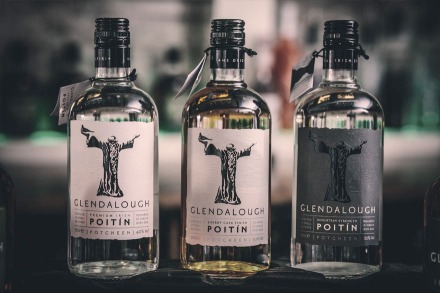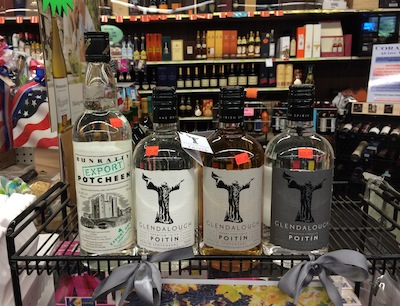
Apple Spiced Martini
“I love the idea of enjoying an apple when they’re at their best,” says chef Marcus Samuelsson about this cocktail creation. “And the spices remind me of a warm apple pie during the autumn holidays.”
2 oz. vodka (Samuelsson uses SKYY)
1/2 oz. fresh lime juice
1/2 oz. apple-spiced simple syrup
2 dashes Angostura bitters
Tools: shaker, strainer
Glass: coupe
Garnish: apple fan
Combine all ingredients and shake with ice cubes. Strain into a chilled glass and garnish.
Apple-Spiced Simple Syrup
1 tsp. ground cinnamon
1 tsp. ground ginger
1 tsp. ground allspice
1 tsp. ground nutmeg (freshly ground, if possible)
1 cup granulated sugar
1 slice of a red apple, 1/4-inch thick
1/2 cup water
Combine all ingredients in a small saucepan, bring to a boil and stir to combine. Remove from heat and let cool to room temperature. Double strain into an airtight container and keep refrigerated for up to two weeks.
Caramel Apple Cider
Add caramel vodka to hot apple cider, sprinkle cinnamon on top.
English Christmas Punch
1 bottle (750 mL) dark rum
2 bottles (750 mL) dry red wine
3 cups tea
½ cup orange juice
½ cup lemon juice
2 cups sugar
Combine wine, tea, and juices in a saucepan. Heat well. Gradually stir in sugar and rum. Serve warm. Serves about 25.
Eggnog
4 egg yolks
1/2 cup sugar
2 cups milk
2 whole cloves
Pinch of cinnamon
1 cup cream
1 teaspoon freshly grated nutmeg
1 teaspoon vanilla extract
2 Tbsp each of bourbon and rum or brandy, or to taste (can omit for kid-friendly eggnog)
*4 egg whites (optional)
In a large bowl, use a whisk or an electric mixer to beat egg yolks until they become somewhat lighter in color. Slowly add the sugar, beating after each addition, whisking until fluffy.
Combine the milk, cloves, and cinnamon in a thick-bottomed saucepan. Slowly heat on medium heat until the milk mixture is steamy hot, but not boiling.
Temper the eggs by slowly adding half of the hot milk mixture into the eggs, whisking constantly while you add the hot mixture. Pour the mixture back into the saucepan.
Cook on medium heat, stirring constantly with a wooden spoon, until the mixture begins to thicken slightly, and coats the back of the spoon. It helps to have a candy thermometer, but not necessary; if you have one, cook until the mixture reaches 160°F. Do not allow the mixture to boil, or it will curdle. (If the mixture does curdle you may be able to save it by running it through a blender.) Remove from heat and stir in the cream. Strain the mixture through a mesh strainer to remove the cloves. Let cool for one hour.
Mix in vanilla extract, nutmeg, and bourbon/rum and brandy (feel free to omit for kid-friendly eggnog). Chill.
Mulled Wine
4 cups apple cider
1 (750-ml) bottle red wine, such as Cabernet Sauvignon
1/4 cup honey
2 cinnamon sticks
1 orange, zested and juiced
4 whole cloves
3 star anise
4 oranges, peeled, for garnish
Directions
Combine the cider, wine, honey, cinnamon sticks, zest, juice, cloves and star anise in a large saucepan, bring to a boil and simmer over low heat for 10 minutes. Pour into mugs, add an orange peel to each and serve.
Pumpkin White/Black Russian
1 1/2 ounces vanilla-flavored vodka
1/2-ounce Pumpkin spice Kahlua
For a White Russian add cream, to fill
Holiday Spiced Manhattan
Infused Vermouth:
2 cups sweet vermouth
1 tsp allspice
2 cinnamon sticks
2 whole cloves
1 dash cayenne pepper
1 dash sea salt
Manhattan Cocktail:
2.5 oz Hennessy cognac
.75 oz infused vermouth
Dash of angostura bitters
Twist of orange
Sprinkle of fresh nutmeg
To Infuse the Vermouth: Heat vermouth to just before boiling. Add all dry ingredients. Turn off heat, cover with lid and let steep for several hours. Pour through sifter into empty container.
For each Manhattan Cocktail: Pour Hennessy, vermouth and bitters in shaker. Add ice and shake. Pour into martini glass. Add twist of orange and sprinkle or zest nutmeg over the top.



 We get excited pretty easily at Vinnin Liquors and this year
We get excited pretty easily at Vinnin Liquors and this year

 10 ounces vodka
10 ounces vodka Dark and Stormy Death Punch
Dark and Stormy Death Punch
 Calorie Counter
Calorie Counter Most important – the higher the alcohol proof, the higher the calories. So 120 proof bourbon or a 96 proof gin will have a few more calories. But don’t be fooled by lower proof cordials or liqueurs – this category adds sugar or other sweeteners after distillation, which is why most cordials are creamy, sweet and delicious!
Most important – the higher the alcohol proof, the higher the calories. So 120 proof bourbon or a 96 proof gin will have a few more calories. But don’t be fooled by lower proof cordials or liqueurs – this category adds sugar or other sweeteners after distillation, which is why most cordials are creamy, sweet and delicious! and limes instead of using calorie and sugar-laden sour mix. Citrus provides a lot of flavor to a cocktail and brightens up the drink – with barely any calories!
and limes instead of using calorie and sugar-laden sour mix. Citrus provides a lot of flavor to a cocktail and brightens up the drink – with barely any calories! Single malts derive their unique qualities and character from the farms that grow the barley – selected as carefully as a winemaker selects his fruit. From guarded and respected water sources, the size, shape and design of the still, the method of heating the still, the malting process and even the casks selected for aging – all of these factors have a dramatic effect on the finished product. Perhaps the least understood influence on the malt would be the local environment in which the malt is aged. Dunnage (aging shed) locations are carefully selected to enhance flavor.
Single malts derive their unique qualities and character from the farms that grow the barley – selected as carefully as a winemaker selects his fruit. From guarded and respected water sources, the size, shape and design of the still, the method of heating the still, the malting process and even the casks selected for aging – all of these factors have a dramatic effect on the finished product. Perhaps the least understood influence on the malt would be the local environment in which the malt is aged. Dunnage (aging shed) locations are carefully selected to enhance flavor.
 m the agave plant (which looks like an overgrown aloe) and follow specific guidelines to ensure quality. Think of it like champagne, which can only come from the Champagne region in France; anything else is sparkling wine.
m the agave plant (which looks like an overgrown aloe) and follow specific guidelines to ensure quality. Think of it like champagne, which can only come from the Champagne region in France; anything else is sparkling wine.